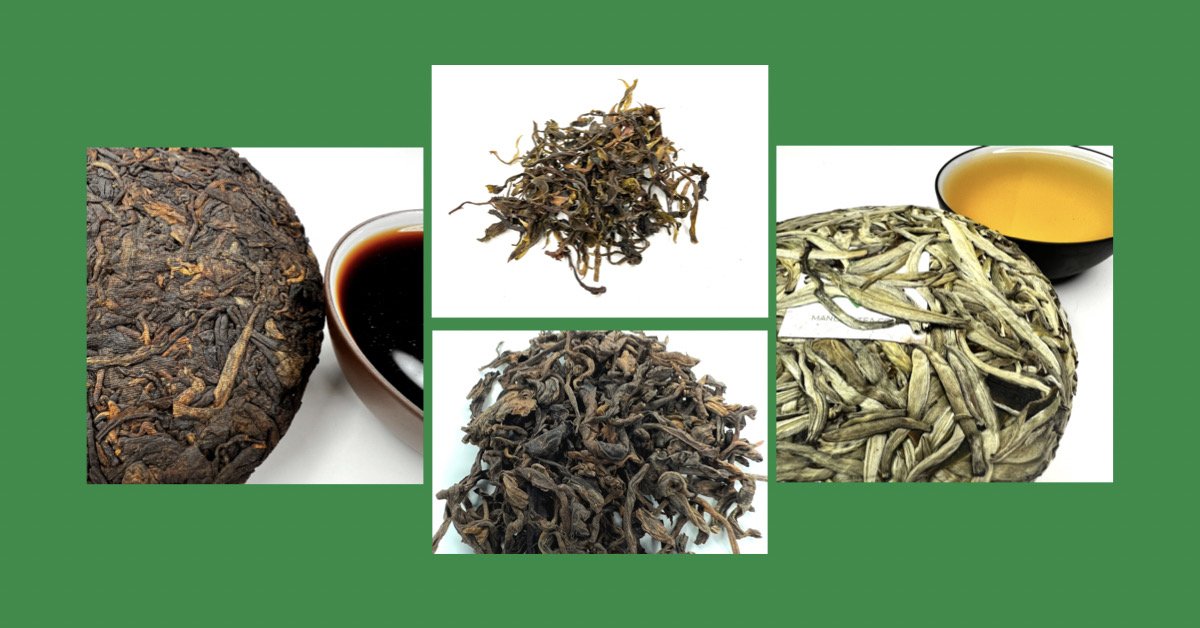Pu’er tea is often confusing for newcomers. They may have had an earthy, dark ripe tea and assume that is what all pu’er is like. It is not. As a matter of fact, the raw style is the original pu’er tea and the two types differ significantly. Let’s explore what makes a tea a ripe or a raw pu’er.
*Raw pu’er may also be referred to as: green, uncooked, sheng, unfermented. The leaf, once picked an withered, undergoes a process of firing in a large wok-like container during which most of the enzymatic action is arrested. This is referred to as “kill green”. The leaf is then set out under the sun on bamboo mats in order to dry. Once dried, the leaf is called mao cha aka “unfinished tea”. When the leaves are steamed and pressed into cakes or brick, it is then pu’er tea. Raw style pu’er tea is a living, breathing tea, with oxidation and fermentation occurring within the cake.
If stored properly, raw pu’er will deepen in flavor, complexity and character sometimes over decades! Raw pu’er can have grassy, bitter sweet and floral qualities to it and the tea liquor is lighter in color when brewed. For brewing temperatures, we use anywhere from 195ºf to full boil, preferring the cooler temps for younger teas (often increasing temps in later steepings). As raw pu’er ages, flavors may smooth out and become more earthy, with some drinkers considering a raw tea as “young” if it is under twenty years old.
*Ripe pu’er may be referred to as: black, cooked, shou, shu, fermented. It is a fairly recent development in the world of tea, popularized in the early/mid-1970’s. In the case of ripe tea, the sun-dried leaf undergoes an accelerated fermentation process referred to as wet-piling. During this time, the leaf is piled and moistened, covered and turned over the course of 2 to 8 weeks. The goal was to produce a final product that would mimic an aged raw pu’er, but the results are quite different. The leaf once dried, may be sold as loose leaf or steamed and pressed into cakes and bricks, just like a raw tea.
Because of the ripening process, ripe teas will not change nearly as much over the course of storage and usually peaks in complexity between years ten and twenty. With all the cakes we have commissioned here at Mandala Tea, we really find a ripe tea opening up in flavor at the year-and-a-half to two year mark.
Ripe tea, is famous for it’s much darker tea liquor (see sample pics below). It may be brewed thick and black like espresso and due to it’s heartier nature, requires water at full boil to coax all the flavors from the leaf. The flavor notes of ripe pu’er are more narrow that what occurs in raw tea, with most people using words such as earthy, leathery, mushroomy and briny to describe the tea.
Ripe and raw teas, while both being called pu’er, are really two different animals, with some tea drinkers enjoying both styles while others definitely prefer one over the other. Raw pu’er diehards often consider ripe pu’er a desecration of tea leaves and will not drink it. That being said, here at Mandala Tea, we love both styles, with ripe tea being our most-consumed drink.
So, if you’ve had experiences with ripe pu’er and have decided that it’s not your cup of tea, please do give raw pu’er a try and see what you think of the very distinct differences between the two styles. And for heaven’s sake, play with all the variables of water temp, amount of leaf, steeping times and test for yourself what works best for you! Enjoy!
left: Alchemy ripe, top: Wild Monk loose mao cha, bottom: Sanctuary ripe, right: Turning Wheel raw

